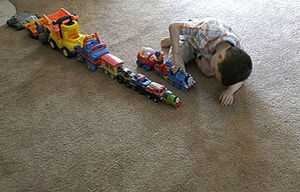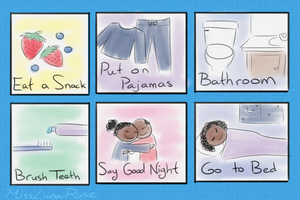MissLunaRose (talk | contribs) (Significant expansion, including how routines are helpful and how parents/caregivers can help) Tags: Visual edit apiedit |
m (Reverted edits by Walmart with a Burger King inside (talk) to last revision by TLPG) Tag: Rollback |
||
| (8 intermediate revisions by 4 users not shown) | |||
| Line 12: | Line 12: | ||
<blockquote>"Reality to an autistic person is a confusing, interacting mass of events, people, places, sounds and sights... Set routines, times, particular routes and rituals all help to get order into an unbearably chaotic life. Trying to keep everything the same reduces some of the terrible fear."<ref>[http://www.autism.org.uk/living-with-autism/understanding-behaviour/obsessions-repetitive-routines/routines-and-change.aspx National Autistic Society: Routines and resistance to change]</ref></blockquote>Routines can reduce [[anxiety]] in autistic people by creating structure and predictability. |
<blockquote>"Reality to an autistic person is a confusing, interacting mass of events, people, places, sounds and sights... Set routines, times, particular routes and rituals all help to get order into an unbearably chaotic life. Trying to keep everything the same reduces some of the terrible fear."<ref>[http://www.autism.org.uk/living-with-autism/understanding-behaviour/obsessions-repetitive-routines/routines-and-change.aspx National Autistic Society: Routines and resistance to change]</ref></blockquote>Routines can reduce [[anxiety]] in autistic people by creating structure and predictability. |
||
| − | Routine may be a necessary part of life for autistic people (adults in particular), because it ensures that certain things get done. A rigid routine helps manage |
+ | Routine may be a necessary part of life for autistic people (adults in particular), because it ensures that certain things get done. A rigid routine helps manage executive dysfunction.<blockquote>"My routines have purpose. Without them, I risk becoming paralyzed or adrift. My carefully organized life goes all to hell. The plants don’t get watered. The dog may or may not get fed. I forget to shower. I get anxious about what’s for lunch before I’ve even finished breakfast. I spend too many hours happily chasing after this idea or that, forgetting that the rest of the world exists." — [[Cynthia Kim]]<ref name=":0">[http://musingsofanaspie.com/2013/06/12/whats-your-function/ Cynthia Kim: What's Your Function?]</ref></blockquote>Kim notes that routines can lessen the cognitive load on autistic people, who can struggle with making choices. If an autistic person eats the same thing for breakfast every day, they do not need to spend time struggling with choosing what to eat.<ref name=":0" /> |
== Struggle with Change == |
== Struggle with Change == |
||
| Line 33: | Line 33: | ||
== References == |
== References == |
||
| − | <references /> |
+ | {{Small|<references />}} |
| + | [[Category:Features of Asperger syndrome]] |
||
[[Category:Features of autism]] |
[[Category:Features of autism]] |
||
Latest revision as of 02:33, 17 July 2021

An example of a routine, in this case lining up toys.
Many autistic people develop routines that become very important. The child may become upset if a routine is interrupted. The routine provides a sense of security and predictability.
Examples of Routines
- A strict schedule: i.e. Must do a task at a certain time, must do therapy at a certain time, etc.
- Lining up objects, especially toys, cans or household objects.
- Having certain meals at certain times.
How Routines Help
"Reality to an autistic person is a confusing, interacting mass of events, people, places, sounds and sights... Set routines, times, particular routes and rituals all help to get order into an unbearably chaotic life. Trying to keep everything the same reduces some of the terrible fear."[1]
Routines can reduce anxiety in autistic people by creating structure and predictability. Routine may be a necessary part of life for autistic people (adults in particular), because it ensures that certain things get done. A rigid routine helps manage executive dysfunction.
"My routines have purpose. Without them, I risk becoming paralyzed or adrift. My carefully organized life goes all to hell. The plants don’t get watered. The dog may or may not get fed. I forget to shower. I get anxious about what’s for lunch before I’ve even finished breakfast. I spend too many hours happily chasing after this idea or that, forgetting that the rest of the world exists." — Cynthia Kim[2]
Kim notes that routines can lessen the cognitive load on autistic people, who can struggle with making choices. If an autistic person eats the same thing for breakfast every day, they do not need to spend time struggling with choosing what to eat.[2]
Struggle with Change
As routines provide comfort to people, change can be rattling.
Cynthia Kim describers herself as having "a very strong NO reflex." She describes how she might feel when her husband asks to spontaneously change plans and go to a movie.
"A movie is not part of my daily routine. It requires contingency planning. It raises many many questions that have to be answered before A Plan can be put into place. What will I see? When? Where? Can I get there in time? Will I have to wait? Will I be early enough to get The Right Seat? Do I want popcorn? How long will the movie run? Should I eat before? After? Where? How much time will that require?"[3]
Handling Inflexibility as a Parent
Bec Oakley at Snagglebox recommends that parents follow set routines for the child, because these can help reduce anxiety. She cautions against breaking routines for the sake of flexibility.
"Kids who cling to routines are looking for signposts amidst the chaos - removing those signposts won’t help them to become more flexible. They need stress and anxiety levels to be low before they can cope with change and unpredictability, and it’s only then that you can start to work on developing flexibility." — Snagglebox[4]

It is important for parents and caregivers to understand why an autistic child feels the way they do. They should talk to the child about it, and help brainstorm ways to make the situation feel less threatening. Ways to help include:
- Providing plenty of reminders about a change in routine: "Remember, next Monday we're going to visit your sister at college."
- Creating routines that allow room for deviation. "On weekends at 4:00, we will play outside. If the weather is bad, we will play inside or read books."
- Visual supports such as picture schedules and light-up timers
- Social stories
- Explaining what to expect in detail: "We'll see your sister's dorm room and meet her roommate. At about noon, we will walk to the cafeteria, get lunch, and eat it outside. Then we will go home."
- Creating an "anxiety plan" in which the child can signal that something is bothering them and they need help or reassurance
- Validating feelings and sharing your positive self talk: "I can see you're really frustrated about this traffic jam. I am too. I wasn't expecting this either, and I hope it clears up soon."
- Encourage stimming and other repetitive behavior as a coping mechanism
